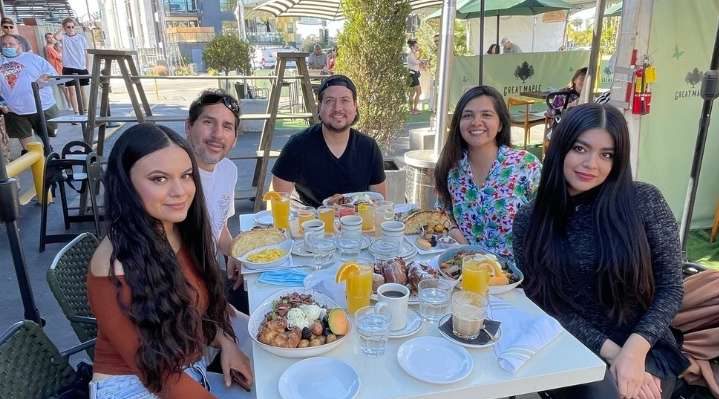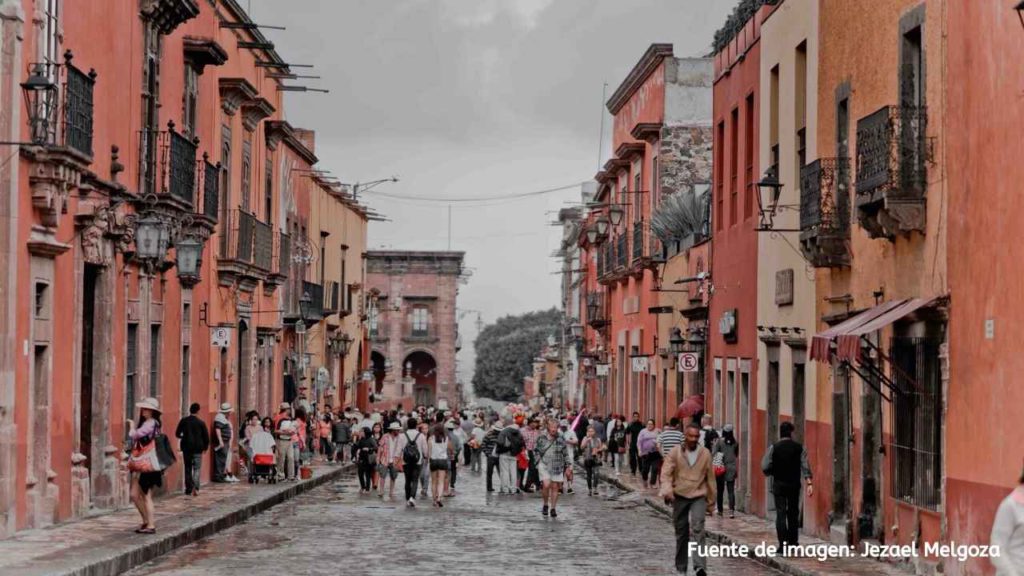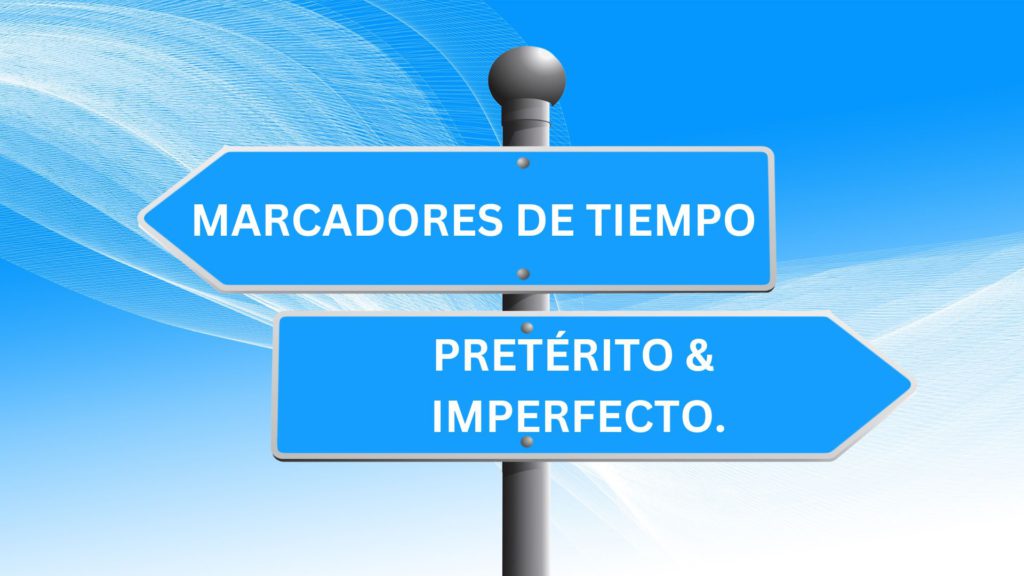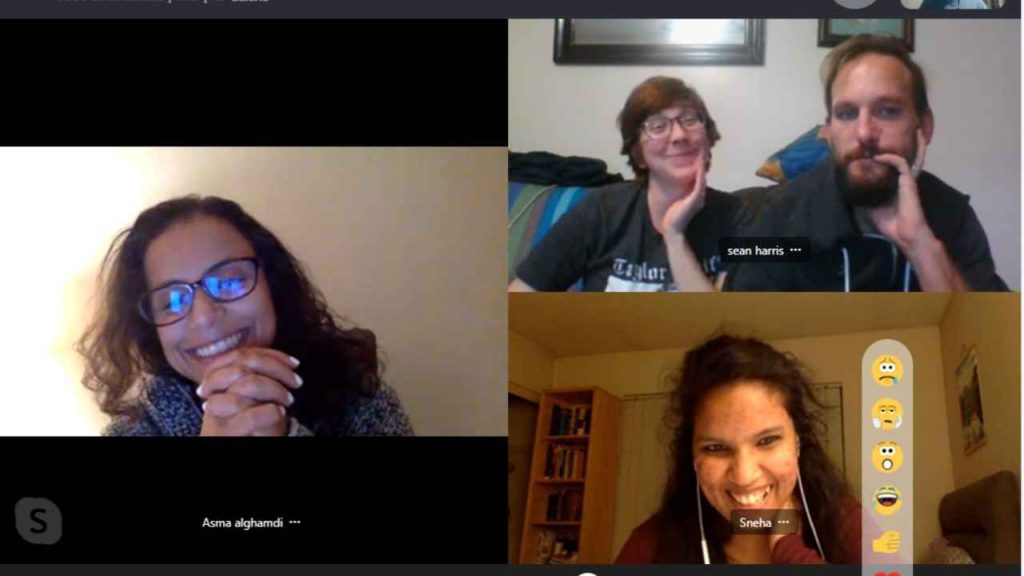Found in Translation: Spanish in the Time of COVID

Hola hola,
Este artículo es una edición especial. Amanda Makula una de nuestras queridísimas alumnas es el cerebro detrás de esta pieza. El artículo concursó para ser publicado en el periódico “San Diego Reader” pero desafortunadamente no fue seleccionado. Lo estamos compartiendo en nuestro blog ya que Amanda ha hecho un excelente trabajo capturando la esencia de las clases y nuestras escuela durante el tiempo de COVID.
Aquí se los dejo
– Lalo
***
“¡Hola, chicas!” Brenda chirps, welcoming us to class. “¿Cómo están?”
It’s Monday evening, and I’ve just logged into the Culture and Language Center’s Zoom portal for my biweekly language lesson. Each 90-minute small group session is completamente en español: no English allowed. If we don’t know a word in Spanish, we have to use other words –words we do know – to try and explain ourselves.
Signe holds her infant grandson on her lap. She’s logging in from Las Vegas, where she’s visiting her son and his family. We ooh and ahh over the handsome baby and ask questions about her trip.
“El bebé no está tranquilo hoy,” she sighs. In other words, he’s a handful. Amid his cries, she turns off her microphone and listens to the rest of us talk about our days. Michele took her daughter to a playdate, and Connie is planning an event for her church’s women. I share a recent book discovery: Mexican Slang Plus Graffiti. It has the kind of words we don’t learn in class, the kind you don’t hear in polite conversation. But it’s a hit here.
“¡Qué interesante!” my classmates exclaim. “Por favor, ¡algunos ejemplos!” They want examples, and I’m happy to oblige.
La maestra Brenda listens attentively throughout our conversation, occasionally typing new words into the chat box or chiming in to clarify a grammatical point. She is ceaselessly encouraging: soft with corrections, enthusiastic with praise. Sometimes she shares stories from her own life, like how she adopted her dogs (her dear perritos) from the streets of Tijuana. But her goal is to get us to talk as much as possible so that we practice vocabulary, pronunciation, and verb conjugations.
After about 45 minutes of discussion, Brenda announces it’s time for the formal part of the lesson: la gramática. I know it’s nerdy, but this is my favorite part. Grammar, to me, feels revolutionary, like applying science to a work of art. Today we’re going to cover la voz pasiva – the passive voice. Brenda shares her screen, explaining situations in which it might be used. I open my notebook and begin to take notes.
***
Nearly two years ago, at the beginning of the pandemic, I began to reflect with so many activities and social outlets shuttered. I was very fortunate to work remotely, but I needed something to do besides ruminating and watching Netflix during my non-work hours. If I was going to be sequestered at home for days, weeks, or more, I needed something to do, a new challenge to tackle. To what end, I wondered, should I apply myself? What had I always wanted to do but never had the time? What had I put off, confident that “someday” the right conditions would fall into place?
The answer came to me quickly: I needed to learn Spanish.
I had briefly studied the language in my rural Iowa high school, and, alongside an extracurricular in theater, it was the closest I came to love and romance during those turbulent years. I loved going to class, loved trying out new phrases and deciphering their meaning, loved delighting in the sounds and expressions of a language so ornate yet efficient. What would it be like to be a character from our textbook? I wondered. To live in Mexico City, Buenos Aires, or Madrid, visit famous museums and meet up with amigos for café con leche afterward, just like they always seemed to be doing.
After high school, I meant to continue learning the language – I really did. But the following years introduced major distractions, as they tend to do as one builds a life and career. Learning Spanish had to compete with getting married, starting a job, setting up a home. Time was elusive; there never seemed to be enough to shuffle Spanish into the mix. Then, a few years ago, a job change and cross-country move brought me to San Diego.
In San Diego, Spanish is everywhere. You see it on signs, billboards, menus; you hear it on the trolley, at the doctor’s office, in the library. According to language data collected by San Diego County, nearly 25% of the population five years and older speak Spanish at home, with some regions such as South Bay and the city of Chula Vista at a much higher rate (62%). Moving to San Diego gave me a second chance and a responsibility to learn Spanish. Why I wondered, should I expect 25, or 62, percent of people to communicate with me in a language –English – that isn’t their primary tongue? Why shouldn’t I speak theirs?
This responsibility wasn’t just an abstraction, either. I had real opportunities to work with representatives of Chicano Park, Logan Heights, and the local lowriding community at my new job. Our interactions would be richer, and I knew if I spoke Spanish. If I respected their language and culture enough to learn more about it.
And so, in the strange new world of the pandemic, I decided I would learn Spanish. I just had to figure out how.
***
In 2017, I took a day trip to Tijuana with Turista Libre, a local company founded by journalist Derrik Chin with the intent to help participants experience the city “like a local.”
(According to their website, the organization is currently closed due to the pandemic.) Riding the bus around TJ, we received goody bags filled with souvenirs, Mexican candy – and a “$40 Off” discount to a San Diego language school: the Culture and Language Center, or CLC.
Somehow, three years later, I still had that coupon, which led me to Lalo.
Eduardo “Lalo” Vega is a self-described “language enthusiast” and the program director of the CLC. Lalo hails from Colombia and first moved to the U.S. twenty years ago. He studied international business at San Diego State University, served four years in the Navy, and went on to study Mandarin Chinese at Mesa College. In 2011, he traveled to China enrolled in a Mandarin immersion program. He also discovered a new passion: teaching.
“There was a guy who had started an English school next to the university, and he offered me the opportunity to go teach English classes to these kids,” he explains. “I remember my very first class connecting with the kids. The experience was so fulfilling that I fell in love. My heart was in education.”
Eventually, he returned to San Diego with a clarity of purpose. He wanted to teach, but the demand wasn’t for English tutors. It was for Spanish.
“I posted an ad on Craigslist,” he says, “and became certified in teaching Spanish as a second language.” He began teaching out of coffee shops. “I got one student, two students, then six students. The snowball kept growing.”
He taught and shared office space with Pura Buena Onda for the next three years, a Spanish school in North Park. Before long, his “snowball” swelled to 30 students, and he realized it was time to start his school. Lalo’s wife Chayo, whom he calls the “backbone” of the business, helped him remodel the building that would become the school.
“The three of us – me, Chayo, and a contractor from TJ – took down walls, installed flooring, scraped the popcorn ceiling. I worked between 5 AM and 11 AM, and then I would teach class afterward. It was only for like three weeks, but it was a pretty intense three weeks.”
From its launch, the CLC sought to build more than language skills. “We are community-oriented,” Lalo emphasizes. “The school is the vessel to many other experiences.” Before the pandemic, the student experience included in-person gatherings and immersion trips ranging in length from one to ten days. At one point, the CLC offered ten trips per year, and some students attended repeatedly. Then, in March 2020, COVID-19 hit. Like many others, he assumed the switch to virtual would be short-lived.
“I still remember the email that I had to send out: starting March 19, everything’s going to be conducted online for the next two weeks,” he muses. “And now it’s almost two years.” The pandemic forced a pivot to online interactions. Still, most students stayed in the program, and the change allowed Lalo to experiment with new forms of instruction like virtual workshops and conversation clubs. He also premiered a unique, all-in-one platform where students and teachers can post messages, hold discussions, access the school’s blog and podcast, and join classes and special events.
The fact that there’s something for everyone has helped Lalo attract a broad customer base. Boomers are looking for a new hobby, young professionals who need Spanish for work or travel, people in a relationship with a Spanish-speaking partner, and heritage speakers who want to reconnect with their culture. But despite their differences, there is a common denominator.
“It’s people from all walks of life, but all of our students share enthusiasm and passion for the language and the culture,” Lalo says. “Right now, we have an 80-year-old, and they’re in the same class as a 30-something. And they get along very well because they share that fundamental value.”
***
As a student, the CLC’s emphasis on community is what I love most. San Diego is a big place. For all its wonders – the beaches, music, tacos, and beer – it can be lonely to navigate the city as a transplant, especially with the social restrictions of the pandemic. On any given day, most of my interactions are transactional – exchanging goods and services – with someone I’ve never met before and will probably never see again. It can feel empty, isolating. But there is connection and community in my Spanish class, where I interact week after week with the same people. They are older and younger than me, from different backgrounds and lifestyles. But in the classroom, we are all just students, united by a common struggle: to speak, hear, and be understood.
In On the Plain of Snakes, his Mexico travelogue, Paul Theroux writes that “in studying a language, being asked and answering direct questions, you reveal yourself . . . nowhere are you more naked than in the back-and-forth of classroom conversation.”
In my experience, he’s right. To learn a language is to be vulnerable, forced into intimacy with one’s teacher and classmates, even with oneself. You fumble to express yourself. You feel stupid and uncomfortable. In the classroom, we must lay ourselves bare and extend grace. As we build trust, our discussions evolve from sharing weekend plans to confessing embarrassing truths. In doing so, we experience true community.
And so, almost two years later, I’m still here with the CLC, attending class, doing homework. Making equal parts progress and mistakes. I’m now only two courses away from the “B.”
(intermediate) level. Some days, I still feel like a total beginner, like I’m thinking in slow motion. Other days, the words come quickly, and I’m heartened. One day, I will speak and understand Spanish effortlessly. I will take my Spanish beyond the classroom and out into the world. Someday, maybe, when I go to sleep, I will even dream en español. But no matter how much I have learned and how much I have yet to learn, I’ve found so much beauty in the process. Right now, with my teacher and my classmates at my (virtual) side, I am happy to relish the journey.
Lalo, meanwhile, is dreaming big. He’s retrofitting an old van to take on road trips and document his travels – in Spanish, of course – on his YouTube channel. His first destination? He wants to go all the way down to Panama. I can’t wait to watch it. But right now, I hope you’ll excuse me. I have to get back to class.
Amanda Makula





